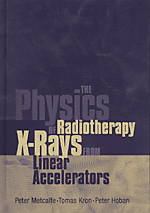
The Physics of Radiotherapy X-Rays from Linear Accelerators (softcover)
Author: Peter Metcalfe, Tomas Kron and Peter HobanISBN: 9780944838761 ISBN10: 0944838766
Published: 1997 | 493 pp | Softcover
OUT OF PRINT
Health Physics | September 1998
As the title states, this text provides a review of the current state of the art of the application of x rays from linear accelerators in the practice of radiation oncology. The authors prove to have an excellent command of these topics, which they communicate in a phenomenological style with just enough mathematics where required to be useful to the practicing radiotherpy physicist as well as a newcomer to the field. This book should be required reading for someone preparing for board exams in radiation oncology physics. Excellent figures are provided, which help in understanding some of the esoteric subjects that are addressed.
The first chapter provides a description of the basic components and characteristics of linear accelerators. Chapter two discusses the interaction of photons and electrons. This includes the basic properties as well as some examples drawn from Monte Carlo calculations, which show effects that occur when x rays progress through tissues. The problem of charged particle disequilibrium with high energy x-ray beams is elucidated. Chapter three discusses the various dosimeters used to measure radiation dosage as well as the protocols that are currently in vogue for these measurements. Potential pitfalls in the applications are stressed throughout the discussions. Chapter four discusses the characteristics of x-ray beams and the parameterization that is used for dosage calculations and treatment planning. Brief discussions of shielding properties and routine quality assurance tests are included in this chapter. Chapter five reviews dosage calculations and basic treatment planning. Chapter six discusses photon beam modeling and inhomogeneity corrections in computer treatment planning. Chapter seven addresses the very latest methods in computer treatment planning: Monte Carlo and convolution/superposition methods. The final chapter is a bonus discussion of the radiobiological considerations in radiation oncology.
Each chapter has what appears to be a generous list of references. Although I mentioned the usefulness of the figures above, there are a few errors that should be mentioned. Fig. 2.23 is the same as Fig. 2.24 but difference captions, Fig. 5.9 and Fig. 5.10 have the same caption, and some of the labeling of graphical figures in chapter two is confusing.
Donald E. Velkley


